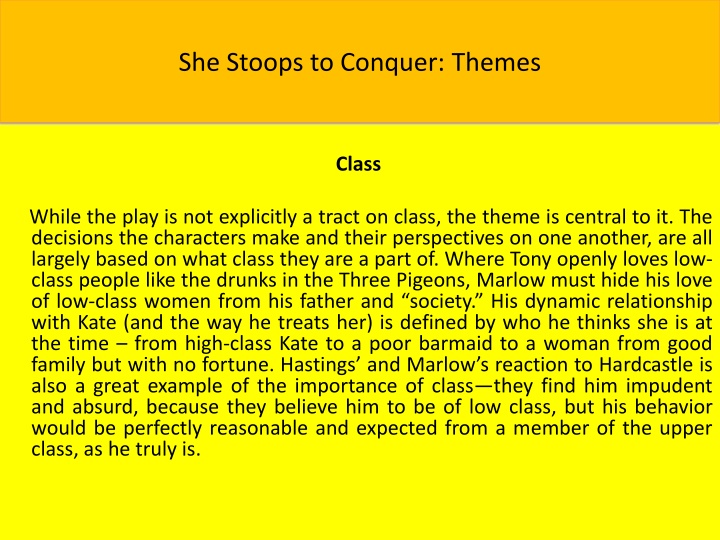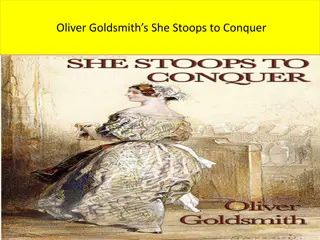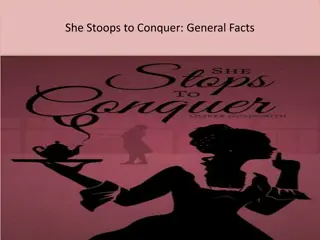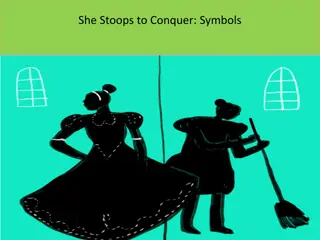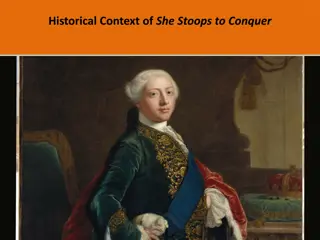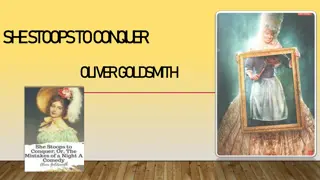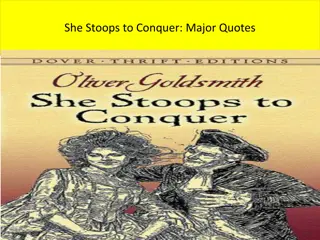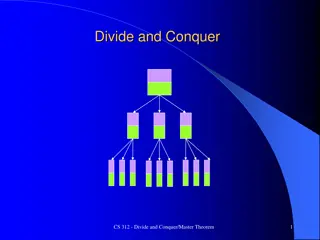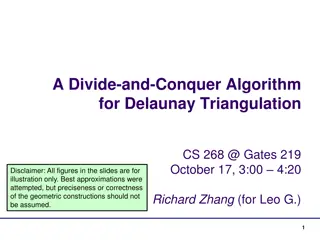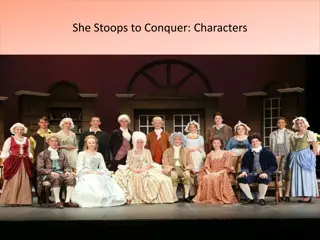Themes Explored in "She Stoops to Conquer
The play "She Stoops to Conquer" delves into themes of class, money, behavior/appearance, and moderation. Class distinctions shape character interactions, while money influences decisions and relationships. The satire on aristocratic behavior highlights misconceptions based on appearances. The conflict between town and country manners is explored through characters like Kate, who appreciates the values of both worlds. These themes underscore the complexities of societal norms and personal relationships within the play.
Download Presentation

Please find below an Image/Link to download the presentation.
The content on the website is provided AS IS for your information and personal use only. It may not be sold, licensed, or shared on other websites without obtaining consent from the author.If you encounter any issues during the download, it is possible that the publisher has removed the file from their server.
You are allowed to download the files provided on this website for personal or commercial use, subject to the condition that they are used lawfully. All files are the property of their respective owners.
The content on the website is provided AS IS for your information and personal use only. It may not be sold, licensed, or shared on other websites without obtaining consent from the author.
E N D
Presentation Transcript
She Stoops to Conquer: Themes Class While the play is not explicitly a tract on class, the theme is central to it. The decisions the characters make and their perspectives on one another, are all largely based on what class they are a part of. Where Tony openly loves low- class people like the drunks in the Three Pigeons, Marlow must hide his love of low-class women from his father and society. His dynamic relationship with Kate (and the way he treats her) is defined by who he thinks she is at the time from high-class Kate to a poor barmaid to a woman from good family but with no fortune. Hastings and Marlow s reaction to Hardcastle is also a great example of the importance of class they find him impudent and absurd, because they believe him to be of low class, but his behavior would be perfectly reasonable and expected from a member of the upper class, as he truly is.
She Stoops to Conquer: Themes Money One of the factors that keeps the play pragmatic even when it veers close to contrivance and sentiment is the unavoidable importance of money. While some of the characters, like Marlow and Hardcastle, are mostly unconcerned with questions of money, there are several characters whose lives are largely defined by a lack of access to it. Constance cannot run away with Hastings because she worries about a life without her inheritance. When Marlow thinks Kate is a poor relation of the Hardcastles, he cannot get himself to propose because of her lack of dowry. And Tony seems to live a life unconcerned with wealth, although the implicit truth is that his dalliances are facilitated by having access to wealth.
She Stoops to Conquer: Themes Behavior/Appearance One of the elements Goldsmith most skewers in his play s satirical moments is the aristocratic emphasis on behavior as a gauge of character. Even though we today believe that one s behavior in terms of low versus high class behavior does not necessarily indicate who someone is, many characters in the play are often blinded to a character s behavior because of an assumption. For instance, Marlow and Hastings treat Hardcastle cruelly because they think him the landlord of an inn, and are confused by his behavior, which seems forward. The same behavior would have seemed appropriately high-class if they hadn t been fooled by Tony. Throughout the play, characters (especially Marlow) assume they understand someone s behavior when what truly guides them is their assumption of the other character s class.
She Stoops to Conquer: Themes Moderation Throughout the play runs a conflict between the refined attitudes of town and the simple behaviors of the country. The importance of this theme is underscored by the fact that it is the crux of the opening disagreement between Hardcastle and his wife. Where country characters like Hardcastle see town manners as pretentious, town characters like Marlow see country manners as bumpkinish. The best course of action is proposed through Kate, who is praised by Marlow as having a refined simplicity. Having lived in town, she is able to appreciate the values of both sides of life and can find happiness in appreciating the contradictions that exist between them.
She Stoops to Conquer: Themes Contradiction Most characters in the play want others to be simple to understand. This in many ways mirrors the expectations of an audience that Goldsmith wishes to mock. Where his characters are initially presented as comic types, he spends time throughout the play complicating them all by showing their contradictions. Most clear are the contradictions within Marlow, who is both refined and base. The final happy ending comes when the two oldest men Hardcastle and Sir Charles decide to accept the contradictions in their children. In a sense, this theme helps to understand Goldsmith s purpose in the play, reminding us that all people are worthy of being mocked because of their silly, base natures, and no one is above reproach.
She Stoops to Conquer: Themes Comedy Though it is only explicitly referred to in the prologue, an understanding of Goldsmith s play in context shows his desire to reintroduce his audience to the laughing comedy that derived from a long history of comedy that mocks human vice. This type of comedy stands in contrast to the then-popular sentimental comedy that praised virtues and reinforced bourgeois mentality. Understanding Goldsmith s love of the former helps to clarify several elements of the play: the low scene in the Three Pigeons; the mockery of baseness in even the most high-bred characters; and the celebration of absurdity as a fact of human life.
She Stoops to Conquer: Themes Deceit/Trickery Much of this play s comedy comes from the trickery played by various characters. The most important deceits come from Tony, including his lie about Hardcastle s home and his scheme of driving his mother and Constance around in circles. However, deceit also touches to the center of the play s more major themes. In a sense, the only reason anyone learns anything about their deep assumptions about class and behavior is because they are duped into seeing characters in different ways. This truth is most clear with Marlow and his shifting perspective on Kate, but it also is true for the Hardcastles and Sir Charles, who are able to see the contradictions in others because of what trickery engenders.
She Stoops to Conquer: Themes Appearances and Reality Much of the comedy of Goldsmith s play depends on confusion between appearance and reality. After all, Marlow s misperception of Mr. Hardcastle s house as an inn drives the narrative action in the first place. Ironically, Goldsmith s comedy allows appearance to lead to the discovery of reality. Kate s deception leads her to discover Marlow s true nature. Falling in love when he thinks her a barmaid, he declares his decision to defy society and marry her in spite of the differences in their social class. Her falsehood allows him to relax with her and reveal his true self.
She Stoops to Conquer: Themes Truth and Falsehood Thematically related to the theme of Appearance and Reality, Goldsmith uses falsehood to reveal the truth. Most obviously Tony s lie about Mr. Hardcastle s mansion being an inn produces the truth of the lovers affections. Lying also leads to poetic justice. When Constance asks to wear her jewels, Mrs. Hardcastle lies and tells her they have been lost. Tony takes the jewels to give to Hastings, and when Mrs. Hardcastle goes to find them, they have been lost. Her lie has become true.
She Stoops to Conquer: Themes Sex Roles In many ways, Goldsmith s She Stoops to Conquer satirizes the ways the eighteenth-century society believed that proper men and women ought to behave. While the play shows the traditional pattern of male-female relations in Hastings s wooing of Constance, it also reverses the era s sexual etiquette by having Kate pursue Marlow.Goldsmith s comedy raises serious issues, however. On the eighteenth century s marriage market, many people married for money, land, or title.
She Stoops to Conquer: Themes Class Bias Until Kate teaches him a lesson, Marlow responds to women solely on the basis of their status in society. He looks down on women of the lower class but is wholly at ease around them; he esteems women of the upper class but is painfully shy around them. Like the London society in which he was brought up, he assumes that all women of a certain class think and act according to artificial and arbitrary standards expected of that class. As for Mrs. Hardcastle, she appears to assess a person by the value of his or her possessions.
She Stoops to Conquer: Themes Love Ignores Social Boundaries Although prevailing attitudes among England s elite classes frown on romance between one of their own and a person of humble origin, Marlow can t help falling in love with a common barmaid (who is, of course, Kate in disguise).
She Stoops to Conquer: Themes Hope for Flawed Humanity Although Marlow makes a fool of himself as a result of his upper-class biases, Kate has enough common sense to see through the London hauteur encasing him and to appreciate him for his genuinely good qualities which are considerable, once he allows them to surface. Also, Mrs. Hardcastle, in spite of her misguided values, enjoys the love of her practical, down-to- earth husband. He, too, is willing to look beyond her foibles in favor of her good points.
She Stoops to Conquer: Themes Money Breeds Indolence Tony Lumpkin will get 1,500 pounds a year when he comes of age. Thus, without financial worries, he devotes himself to ale and a do- nothing life.
The End SEE YOU NEXT LESSON!
